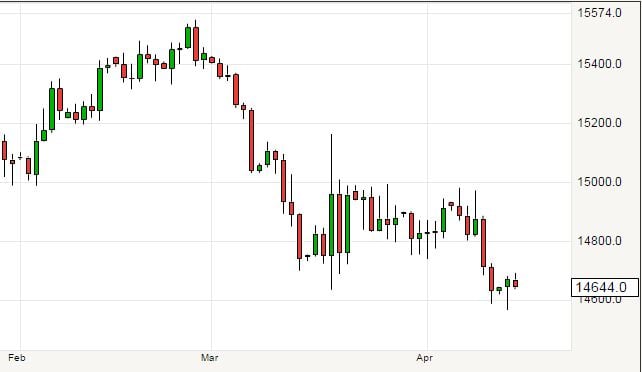GBP-USD: Outlook Dominated by Key Support Levels
The pound to dollar exchange rate (GBP-USD) is on course to break beyond inter-year lows according to a set of fresh forecasts.
“We are starting to approach some strong long-term technical support levels in cable between 1.4350/1.4500 and I doubt very much if these levels will break easily." - Sean Lee @ ForexTell.
The pound sterling has hit fresh five year lows against the US dollar ensuring those looking to trade out of GBP and into USD are left wondering whether the tide will ever turn in their favour.
According to latest predictions from a number of leading research houses, the near- to medium-term picture remains dominated by a multi-month period of weakness.
Momentum is certainly pitted against the UK currency with the pair trading below its 20, 50 and 100 day moving averages. The momentum indicator is below zero and advocating for further declines.
But it remains important that those looking to enter the market are aware of current nearer-term trends surrounding GBP-USD and what numbers will be of significance.
At present we are looking at those numbers that provide ‘support’ i.e levels that the dollar is struggling to push the pound below.
If these levels can hold it could offer sellers of sterling bouts of relief and better exchange rates.
At the time of writing we see the pound dollar exchange rate located at 1.4646. Graphically, the picture looks as follows:
According to ICN Financial, a specialist technical analysis house, the GBP-USD has fallen through the 1.4830 support region; this now invites the possibility of a rapid fall towards the next significantly technical support numbers located at 1.4640 and then 1.4625.
If this level breaks then the prospect of even deeper declines to 1.4500 becomes a real possibility.
Beware: All FX quotes in this piece reference the wholesale markets rates - your bank will affix a discretionary spread to this wholesale rate to derive their profit. However, an independent FX provider will undercut your bank's offer, this can deliver up to 5% more currency in some instances, learn more here.
Why is the Pound Sterling Struggling?
According to CIBC analyst Jeremy Stretch the big problem facing those hoping for better levels to convert pounds into dollars is simply the sheer strength of the Greenback.
The US dollar index - an index that represents the overall performance of the dollar based on a basket of USD pairs - appears biased towards one-month highs above the 100 threshold.
Apparently interest rate differentials between the United States, Europe and the UK remain biased in favour of the US and its dollar.
“The rebound in US 10-year yields, post the four-week moving average of jobless claims plunging to 15-year lows, helped provide a catalyst for residual USD bid interest. The widening in spreads, US Treasuries versus both JGB’s and Bunds, favours residual USD interest,” says Stretch pointing to the underlying financial market conditions that remain in favour of the Greenback.
GBP-USD Biased Lower
As such CIBC say they are amongst those in the market that remain sellers of GBPUSD in anticipation of further weakness.
On top of this, sterling has been undermined further by a growing sense of GBP-negativity owing to political risk, predominantly played out via Sterling weakness versus the USD.
“Into the May 7 poll expect Sterling to be disproportionately hit by any data shortfalls. Having already traded fresh ’15 lows at 1.4624, we remain biased towards 1.4350 targets in upcoming weeks,” says Stretch.
For further insights into the dynamics surrounding the elections, see this forecast note we have published concerning the views at Barclays.
BUT There is a Chance for Relief
It’s not all one-way traffic though - there are those out there who prefer to take a contrarian view as to what the outlook holds for the Cable (this is the long-held nickname given to sterling-dollar).
There remains the chance that the US dollar simply fails to deliver on promised strength.
Such a scenario is currently being envisaged by currency forecasters at investment bank Morgan Stanley.
Analyst Evan Brown says with last week’s US labour market report converging to the broader trend of soft Q1 data, the USD bull-run is set for a pause.
And this is important as it affects interest rate differentials, something we mentioned earlier - interest rates are the single most important issue for exchange rates at the present time.
When the US Federal Reserve decides to raise interest rates is thus of utmost importance.
And, this decision making is unequivocally data-dependent.
While recent US economic data has been disappointing, initial signs of March activity look encouraging.
“If the growth headwinds are indeed temporary in nature and official data picks up, we will look to reinitiate USD longs. In the absence of a near-term catalyst, we expect USD to stay rangebound in coming weeks,” says Morgan Stanley’s Brown.
So while the investment bank is forecasting a pause in GBP-USD weakness, they are not necessarily suggesting an all-out recovery rally is likely.
Indeed, consolidation it seems, is the name of the game.
Backing this view is professional independent currency trader Sean Lee at ForexTell.
In a recent note to followers Lee reckons:
“We are starting to approach some strong long-term technical support levels in cable between 1.4350/1.4500 and I doubt very much if these levels will break easily.
“Resistance levels are pretty clear now between 1.49/1.50 so there will be plenty of swing-trade opportunities between these two parameters.”
It must then again be emphasised that it is the key support levels which must be focussed on.
Whether they break or hold in coming days will determine the outlook through the next few weeks.





